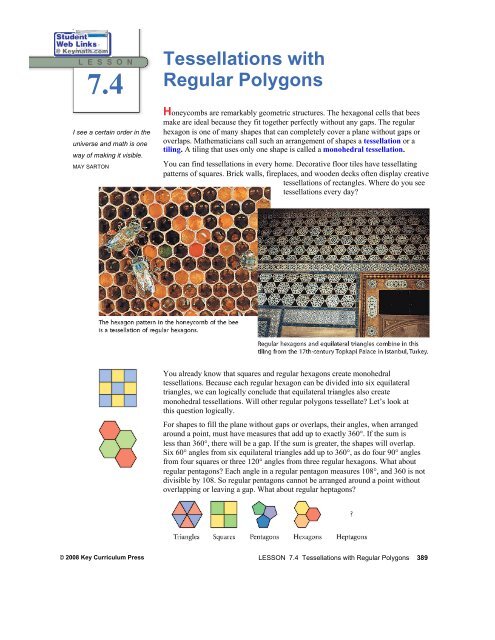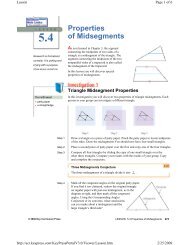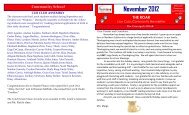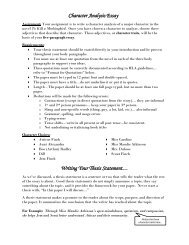7.4 Tessellations with Regular Polygons
7.4 Tessellations with Regular Polygons
7.4 Tessellations with Regular Polygons
You also want an ePaper? Increase the reach of your titles
YUMPU automatically turns print PDFs into web optimized ePapers that Google loves.
L E S S O N<br />
<strong>7.4</strong><br />
I see a certain order in the<br />
universe and math is one<br />
way of making it visible.<br />
MAY SARTON<br />
© 2008 Key Curriculum Press<br />
<strong>Tessellations</strong> <strong>with</strong><br />
<strong>Regular</strong> <strong>Polygons</strong><br />
Honeycombs are remarkably geometric structures. The hexagonal cells that bees<br />
make are ideal because they fit together perfectly <strong>with</strong>out any gaps. The regular<br />
hexagon is one of many shapes that can completely cover a plane <strong>with</strong>out gaps or<br />
overlaps. Mathematicians call such an arrangement of shapes a tessellation or a<br />
tiling. A tiling that uses only one shape is called a monohedral tessellation.<br />
You can find tessellations in every home. Decorative floor tiles have tessellating<br />
patterns of squares. Brick walls, fireplaces, and wooden decks often display creative<br />
tessellations of rectangles. Where do you see<br />
tessellations every day?<br />
You already know that squares and regular hexagons create monohedral<br />
tessellations. Because each regular hexagon can be divided into six equilateral<br />
triangles, we can logically conclude that equilateral triangles also create<br />
monohedral tessellations. Will other regular polygons tessellate? Let’s look at<br />
this question logically.<br />
For shapes to fill the plane <strong>with</strong>out gaps or overlaps, their angles, when arranged<br />
around a point, must have measures that add up to exactly 360°. If the sum is<br />
less than 360°, there will be a gap. If the sum is greater, the shapes will overlap.<br />
Six 60° angles from six equilateral triangles add up to 360°, as do four 90° angles<br />
from four squares or three 120° angles from three regular hexagons. What about<br />
regular pentagons? Each angle in a regular pentagon measures 108°, and 360 is not<br />
divisible by 108. So regular pentagons cannot be arranged around a point <strong>with</strong>out<br />
overlapping or leaving a gap. What about regular heptagons?<br />
LESSON <strong>7.4</strong> <strong>Tessellations</strong> <strong>with</strong> <strong>Regular</strong> <strong>Polygons</strong> 389
a set of triangles,<br />
squares, and hexagons<br />
<strong>with</strong> equal side lengths<br />
pattern blocks (optional)<br />
geometry software<br />
(optional)<br />
390 CHAPTER 7 Transformations and <strong>Tessellations</strong><br />
In any regular polygon <strong>with</strong> more than six sides, each angle has a measure greater<br />
than 120°, so no more than two angles can fit about a point <strong>with</strong>out overlapping.<br />
So the only regular polygons that create monohedral tessellations are equilateral<br />
triangles, squares, and regular hexagons. A monohedral tessellation of congruent<br />
regular polygons is called a regular tessellation.<br />
<strong>Tessellations</strong> can have more than one type of<br />
shape. You may have seen the octagon-square<br />
combination at right. In this tessellation, two<br />
regular octagons and a square meet at each<br />
vertex. Notice that you can put your pencil on<br />
any vertex and that the point is surrounded by<br />
one square and two octagons. So you can call<br />
this a 4.8.8 or a 4.82 tiling. The sequence of<br />
numbers gives the vertex arrangement, or<br />
numerical name for the tiling.<br />
When the same combination of regular polygons (of two or more kinds) meet<br />
in the same order at each vertex of a tessellation, it is called a semiregular<br />
tessellation. Below are two more examples of semiregular tessellations.<br />
There are eight different semiregular tessellations. Three of them are shown above.<br />
In this investigation, you will look for the other five. Fortunately, the remaining five<br />
use only combinations of triangles, squares, and hexagons.<br />
The Semiregular <strong>Tessellations</strong><br />
Find or create a set of regular triangles, squares, and hexagons for this investigation.<br />
Then work <strong>with</strong> your group to find the remaining five of the eight semiregular<br />
tessellations. Remember, the same combination of regular polygons must meet in<br />
the same order at each vertex for the tiling to be semiregular. Also remember to<br />
check that the sum of the measures at each vertex is 360°.<br />
© 2008 Key Curriculum Press
© 2008 Key Curriculum Press<br />
Step 1 Investigate which combinations of two kinds of regular polygons you can use to<br />
create a semiregular tessellation.<br />
Step 2 Next, investigate which combinations of three kinds of regular polygons you can<br />
use to create a semiregular tessellation.<br />
Step 3 Summarize your findings by sketching all eight semiregular tessellations and<br />
writing their vertex arrangements (numerical names).<br />
The three regular tessellations and the eight semiregular tessellations you just found<br />
are called the Archimedean tilings. They are also called 1-uniform tilings because<br />
all the vertices in a tiling are identical.<br />
Mathematics<br />
Greek mathematician and inventor Archimedes<br />
(ca. 287–212 B.C.E.) studied the relationship between<br />
mathematics and art <strong>with</strong> tilings. He described<br />
11 plane tilings made up of regular polygons,<br />
<strong>with</strong> each vertex being the same type. Plutarch<br />
(ca. 46–127 C.E.) wrote of Archimedes’ love of<br />
geometry, “. . . he neglected to eat and drink and<br />
took no care of his person that he was often carried by force to the baths, and<br />
when there he would trace geometrical figures in the ashes of the fire.”<br />
Often, different vertices in a tiling do not have the same vertex arrangement.<br />
If there are two different types of vertices, the tiling is called 2-uniform.<br />
If there are three different types of vertices, the tiling is called 3-uniform.<br />
Two examples are shown below.<br />
There are 20 different 2-uniform tessellations of regular polygons, and 61 different<br />
3-uniform tilings. The number of 4-uniform tessellations of regular polygons is still<br />
an unsolved problem.<br />
LESSON <strong>7.4</strong> <strong>Tessellations</strong> <strong>with</strong> <strong>Regular</strong> <strong>Polygons</strong> 391
EXERCISES<br />
1. Sketch two objects or designs you see every day that are monohedral<br />
tessellations.<br />
2. List two objects or designs outside your classroom that are semiregular tessellations.<br />
In Exercises 3–5, write the vertex arrangement for each semiregular tessellation<br />
in numbers.<br />
3. 4. 5.<br />
In Exercises 6–8, write the vertex arrangement for each 2-uniform tessellation<br />
in numbers.<br />
6. 7. 8.<br />
9. When you connect the center of each triangle across the common<br />
sides of the tessellating equilateral triangles at right, you get another<br />
tessellation. This new tessellation is called the dual of the original<br />
tessellation. Notice the dual of the equilateral triangle tessellation is<br />
the regular hexagon tessellation. Every regular tessellation of regular<br />
polygons has a dual.<br />
a. Draw a regular square tessellation and make its dual. What is the dual?<br />
b. Draw a hexagon tessellation and make the dual of it. What is the dual?<br />
c. What do you notice about the duals?<br />
10. You can make dual tessellations of semiregular tessellations, but they<br />
may not be tessellations of regular polygons. Try it. Sketch the dual of<br />
the 4.8.8 tessellation, shown at right. Describe the dual.<br />
Technology In Exercises 11–14, use geometry software, templates of regular<br />
polygons, or pattern blocks.<br />
11. Sketch and color the 3.6.3.6 tessellation. Continue it to fill an entire<br />
sheet of paper.<br />
12. Sketch the 4.6.12 tessellation. Color it so it has reflectional symmetry but not<br />
rotational symmetry.<br />
392 CHAPTER 7 Transformations and <strong>Tessellations</strong><br />
You will need<br />
© 2008 Key Curriculum Press
13. Show that two regular pentagons and a regular decagon fit about a point, but that<br />
5.5.10 does not create a semiregular tessellation.<br />
14. Create the tessellation 3.12.12/3.4.3.12. Draw your design onto a full sheet of paper.<br />
Color your design to highlight its symmetries.<br />
Review<br />
15. Design a logo <strong>with</strong> rotational symmetry for Happy Time Ice-Cream<br />
Company. Or design a logo for your group or for a made-up<br />
company.<br />
16. Reflect y = x − 4 across the x-axis and find the equation of the<br />
image line.<br />
17. Words like MOM, WOW, TOOT, and OTTO all have a vertical line<br />
of symmetry when you write them in capital letters. Find another<br />
word that has a vertical line of symmetry.<br />
18. Frisco Fats needs to sink the 8-ball into<br />
the NW corner pocket, but he seems<br />
trapped. Can he hit the cue ball to a<br />
point on the N cushion so that it<br />
bounces out, strikes the S cushion, and<br />
taps the 8-ball into the corner pocket?<br />
Copy the table and construct the path of<br />
the ball.<br />
Painted Faces I<br />
Suppose some unit cubes are assembled into a large cube, then some of the faces of this<br />
large cube are painted. After the paint dries, the large cube is disassembled into the unit<br />
cubes, and you discover that 32 of these have no paint on any of their faces. How many<br />
faces of the large cube were painted?<br />
© 2008 Key Curriculum Press<br />
LESSON <strong>7.4</strong> <strong>Tessellations</strong> <strong>with</strong> <strong>Regular</strong> <strong>Polygons</strong> 393<br />
y<br />
x








